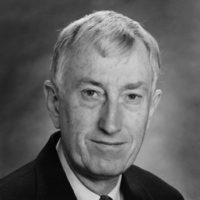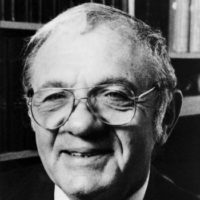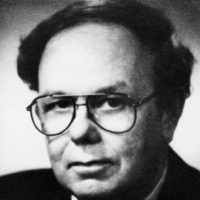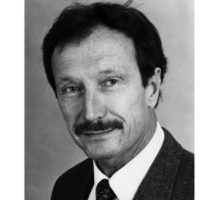
Peter C. Doherty
St. Jude Children’s Research Hospital

Jack L. Strominger
Harvard University

Emil R. Unanue
Washington University School of Medicine

Don C. Wiley
Harvard University

Rolf M. Zinkernagel
University of Zurich
For the discovery of the Major Histocompatibility Complex (MHC) restriction of T-cell recognition.
Peter Doherty
Revolutionary is the best way to describe the work of Peter Doherty, whose research has radically advanced the field of cellular immunology. Working in collaboration with Rolf Zinkernagal, Dr. Doherty performed pivotal experiments that first brought to light the fundamental requirement for T-cell initiation of an immune response: T cells must simultaneously recognize a foreign antigen and a self-protein of the major histocompatibility complex on the surface of antigen-presenting cells.
The epochal discovery by Doherty and Zinkernagel, that MHC proteins restrict T-cell recognition of foreign antigens, inaugurated a new era in immunology, an era of research that would clarify the functions of MHC proteins and elucidate their relationship to T cells. Innumerable insights into autoimmune diseases, graft rejection, organ transplantation, and vaccine design emanate from the explanation of the role MHC proteins play in cell-mediated immunity.
Dr. Doherty's investigations built on earlier studies of graft rejection, particularly the killing of cells by cytotoxic lymphocytes, and the analysis of the immunopathology caused by murine lymphocytic choriomeningitis virus.
In their crucial experiments, Dr. Doherty and Dr. Zinkernagel examined class I MHC haplotype-related differences in mouse immune responses and obtained surprising results. Cytotoxic T cells withdrawn from virally infected mice could lyse virally infected mouse cells in vitro under one condition—when the MHC haplotypes of both the T-cell donor and the infected target cells were identical. When the haplotypes differed, the cytotoxic T cells were ineffective. The activated T-cell assay made the observations possible, but their hypothesis, that a single T-cell receptor recognizes both a self-MHC protein and a foreign antigen on the surface of antigen-presenting cells, was truly original.
The seminal significance of the Doherty-Zinkernagel work lies in the explanatory power of their hypothesis. The idea that a viral antigen could alter a self-MHC protein so that it appears foreign to T cells proposes the mechanism for T-cell immune recognition. The requirement that T cells simultaneously recognize MHC protein accounts for the recognition of foreign MHC and the strength of allograft rejection. Other investigators rapidly extended the Doherty-Zinkernagel discovery to class II MHC restriction of helper T cells, and thus the mechanism of immune recognition by T cells had been solved.
To Peter Doherty, for the epochal discovery of MHC restriction of T-cell recognition and the single T-cell receptor altered-self hypothesis, this 1995 Albert Lasker Basic Medical Research Award is given.
Rolf Zinkernagel
To immunologists, the name Rolf Zinkernagal is synonymous with revolution because of the experiments he performed in collaboration with Peter Doherty, which first showed that T cells simultaneously recognize foreign antigen and a major histocompatibility complex (MHC) self-protein on the surface of antigen-presenting cells. The work was revolutionary because it described the fundamental requirements for T cells to recognize intracellular viral antigens.
Dr. Zinkernagel's and Dr. Doherty's seminal discovery that MHC proteins restrict T-cell recognition of foreign antigens opened the door to a comprehension of the way T cells function in initiating an immune response. The understanding of immunity that would eventually emerge, as well as advances in understanding autoimmune diseases, the genetics of disease susceptibilities, tumor immunity and vaccines, all derive directly from their discovery of the role of MHC proteins in cell-mediated immunity.
Dr. Zinkernagel's landmark 1974 research built upon knowledge accumulated on the genetics of transplantation antigens, their role in regulating antibody responses and disease, and on T-cell immunity and cytotoxic T cells in infectious diseases.
Exploring class I MHC haplotype-related differences in mouse immune responses, Dr. Zinkernagel and Dr. Doherty made the surprising discovery that activated T cells taken from virally infected mice would destroy virally infected mouse cells in vitro only when the donor of the activated T cells and the infected cell lines possessed the identical MHC haplotype. When the haplotypes differed, the activated T cells were ineffective. Their use of cytotoxic T cells for the assay enabled them to make the observation and to put forward their explanatory hypothesis: One T-cell receptor recognizes both antigen and a self-MHC protein on the surface of the infected cell.
The fundamental importance of the Zinkernagel-Doherty discovery to immunology is seen in its explanatory power. The idea that a viral antigen could alter a self-MHC protein so that it appears foreign to T cells proposes the mechanism for T-cell immune recognition. The requirement that T cells simultaneously recognize MHC proteins accounts for the recognition of foreign MHC and the strength of allograft rejection. The Zinkernagel-Doherty discovery was quickly extended by other investigators to human T cells and to T cells with other functions.
To Rolf Zinkernagal, for the landmark discovery of MHC restriction of T-cell recognition and the altered-self hypothesis, this 1995 Albert Lasker Basic Medical Research Award is given.
For pioneering the isolation of class I and class II MHC proteins and their peptide complexes.
Jack Strominger
The brilliant basic research carried out by Jack Strominger has transformed the science of molecular immunology. By isolating and then, in collaboration with Don Wiley, solving the structure of major histocompatibility complex (MHC) proteins and their peptide complexes, Dr. Strominger has precisely defined the parameters of immune recognition by T cells, and translated cellular immunology into the language of atoms.
Dr. Strominger's stellar achievements have advanced the biochemistry of immunology, directly impacting investigations into autoimmune diseases such as multiple sclerosis, rheumatoid arthritis, and diabetes mellitus. In addition, future research into tumor antigens, allograft rejection and antiviral vaccines finds both impetus and inspiration in the discoveries he has made.
After a distinguished early career in which he elucidated the chemistry of bacterial cell walls and the mechanism of action of penicillin, Jack Strominger's interest turned to MHC proteins. In the 1970s, he and his students pioneered the techniques for solubilizing, isolating and purifying both class I and class II MHC proteins from the membranes of human lymphoblastoid cells for separating isotopes and for cloning the MHC genes that encode these proteins. These meticulous studies established that the class I and class II MHC molecules were remarkably similar heterodimeric transmembrane glycoproteins that contained immunoglobulin-like domains and that their polymorphism was based on amino acid variation, which they localized when they obtained the first complete sequences of these proteins.
After the discovery of MHC restriction of T-cell recognition by Zinkernagel and Doherty, and Unanue's demonstration of MHC-peptide binding, Strominger and Wiley would solve the key question in immune recognition: How could a single MHC molecule bind to so many different peptides?
Resolving intricate problems in chemistry is Jack Strominger's forte. With the X-ray crystallographic expertise of Don Wiley, they succeeded together in visualizing the three-dimensional structures of HLA-A2, HLA-A68, and HLA-B27, and in obtaining images of peptides bound to these human class I MHC molecules, as well as of class II molecules and their complexes with both foreign and self peptides and bacterial superantigens.
Between the helices of class I MHC molecules is a long groove with multiple binding sites into which diverse peptides, each of a precise restricted length, will fit. Class II MHC molecules will bind longer peptides that can vary in length, with no restriction in size. These elegant and refined studies have given chemists the first detailed pictures of precisely how peptides are bound, and how the T-cell receptor recognizes foreign antigens.
To Jack Strominger, for pioneering the isolation of and solution to the structures of class I and class II MHC proteins and their peptide complexes, this 1995 Albert Lasker Basic Medical Research Award is given.
For seminal discoveries in antigen processing and MHC-peptide binding which deciphered the biochemical basis of T-cell recognition.
Emil Unanue
For seminal discoveries in antigen processing and MHC-peptide binding which deciphered the biochemical basis of T-cell recognition.
Two decades of extraordinary studies by Emil Unanue have fundamentally advanced the field of molecular immunology. The experiments in which Dr. Unanue demonstrated that molecules of the major histocompatibility complex (MHC) bind to antigenic peptides blazed a trail out of a thicket of theories toward a lucid understanding of how cell-surface antigens are recognized by T lymphocytes.
Dr. Unanue's highly original discoveries began in the late 1960s. By the combination of in vivo cell transfers in mice with cell-culture experiments, he first found direct evidence that the immunogenicity of proteins increased greatly after phagocytosis and catabolism by macrophages. This seminal finding flew in the face of immunological dogma, which held that the macrophage destroyed antigens, and that the immune response targeted folded portions of intact protein molecules.
Despite collegial skepticism, Dr. Unanue proceeded to trace the enhanced response to a fraction of the antigenic protein embedded in the macrophage cell wall. His pivotal observations were quickly confirmed and the macrophage was acknowledged to have a previously unrecognized function—presenting antigen to helper T cells.
Dr. Unanue broke new ground again in the 1980s, following the description of MHC restriction of T-cell recognition by Peter Doherty and Rolf Zinkernagel. He showed that proteins needed to be processed intracellularly prior to their recognition by T cells. In a crucial collaboration with Paul Allen, Dr. Unanue then proved that after internalization and catabolism by macrophages, the immunogenic fragments which appeared on the cell membrane were peptides. The puzzle of immune recognition remained to be solved, however, as Dr. Unanue turned his attention to MHC antigens and the T-cell receptor.
In a landmark paper which has become one of the most widely cited studies in immunology, Dr. Unanue, collaborating with Allen and Babbitt, demonstrated that class II MHC molecules would bind to specific radiolabeled peptides, and that the MHC-peptide complex would activate T cells.
Extension of Dr. Unanue's groundbreaking work revealed that inside antigen presenting cells, MHC molecules bind peptides, protect them from destruction, and transport them to the plasma membrane where T cells will recognize the complex and initiate an immune response.
To Emil Unanue, for seminal discoveries in antigen processing and MHC-peptide binding, which deciphered the biochemical basis of T-cell recognition, this 1995 Albert Lasker Basic Medical Research Award is given.
For visualizing the three-dimensional structures of class I and class II proteins and their complexes with antigens and superantigens.
Don Wiley
The landmark research done by Don Wiley stands as a milestone in molecular immunology. In collaboration with Jack Strominger, he was able to visualize the three-dimensional atomic structure of major histocompatibility complex (MHC) proteins and their antigen binding sites. Dr. Wiley applied the high technology precision of X-ray crystallography to the solution of the biochemistry of T-cell recognition.
Dr. Wiley's extraordinary accomplishments have changed the ground rules of immunology. By providing a precise picture of MHC-peptide binding, he has made the rational design of specific molecules for antiviral vaccines a reality. Research into tumor antigens, allograft rejection, and autoimmune diseases as diverse as multiple sclerosis, rheumatoid arthritis and diabetes mellitus, has made essential advances that originate in the achievements of Don Wiley.
In the 1980s, Dr. Wiley earned early renown for his expertise in X-ray crystallography by determining the structure of the influenza virus hemagglutinin. This work defined the sites of amino-acid variation responsible for the antigenic drift that leads to periodic epidemics of influenza. The studies also revealed how influenza virus binds to cellular receptors and gains entry into cells by fusing the virus's membrane with a cellular membrane.
Following Doherty's and Zinkernagel's discovery of T-cell restriction by MHC proteins, Unanue's demonstration of MHC-peptide binding, and Strominger's isolation and purification of human class I and class II MHC molecules, Wiley—with Pam Bjorkman and colleagues in collaboration with Jack Strominger—provided a molecular picture of MHC glycoprotein and its binding site for foreign and self antigens. The binding site is composed of a long groove running between two alpha helices. Recognition of the compound surface formed by the MHC molecule and the bound peptide provided the molecular mechanism for MHC restricted T-cell recognition.
Using X-ray crystallography, Wiley, Strominger and colleagues determined the three-dimensional structure of the human MHC class I molecules HLA-A2, HLA-A68, and HLA-B27. The structure of HLA-B27 revealed a general binding mode between peptides and class I molecules.
The structure of MHC Class II molecules which present antigens to helper T cells revealed a different binding mode based on similar principles. The interaction between MHC class II molecules and viral antigens, self antigens, and bacterial superantigens all have been elucidated. Don Wiley's classic images are an inspiration to immunologists because they depict the MHC-antigen binding sites, and the atomic details of structures which T cells use to recognize antigens, thereby initiating an immune response.
To Don Wiley, for visualizing the three-dimensional structures of MHC class I and class II proteins and their complexes with antigens and superantigens, this 1995 Albert Lasker Basic Medical Research Award is given.
